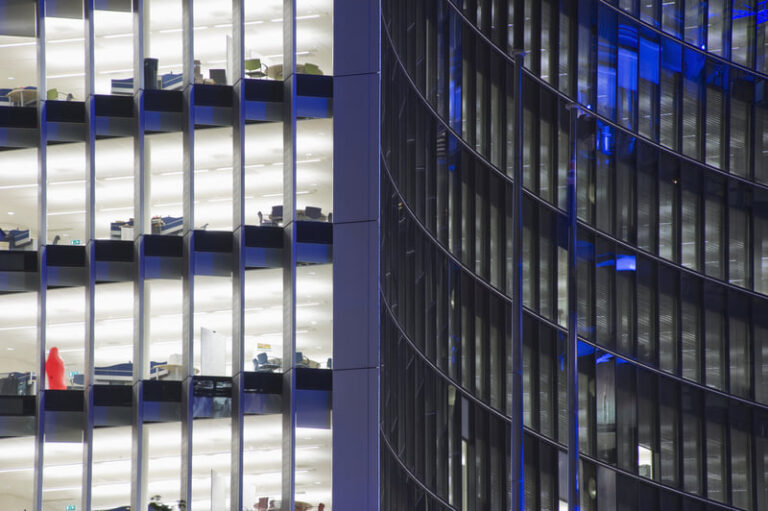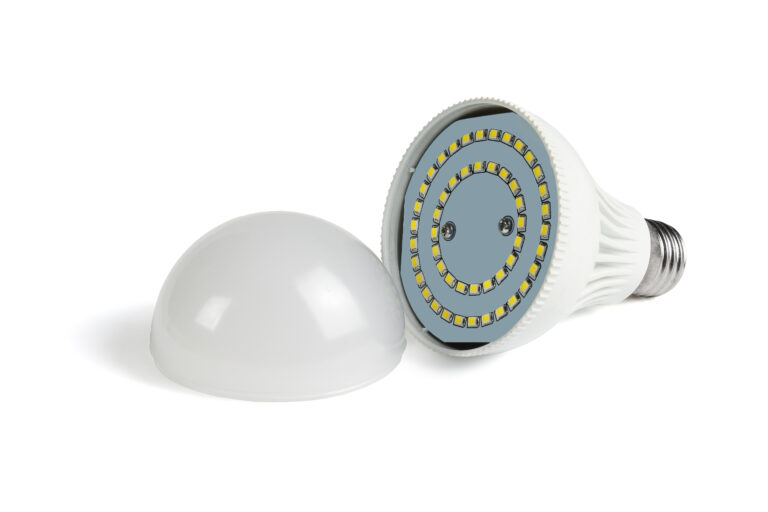As business owners, developers, and consumers, we always look for efficient, cost-effective, and environmentally friendly solutions. LED lighting has become a prominent choice in meeting these requirements. Let’s explore the financial and environmental return on investment (ROI) of LED lighting, how it can improve your business reputation, the role of government incentives and programs in maximizing your LED lighting ROI, and effective planning for your LED upgrade.
Understanding the Basics: What is LED Lighting?
LED lighting, short for light-emitting diodes, is a highly efficient, long-lasting form of solid-state lighting. Unlike traditional incandescent bulbs that rely on filaments, LEDs are semiconductor devices. When an electric current flows through them, they produce light through electroluminescence. This unique way of functioning makes LEDs more energy-efficient and durable than regular lighting options, providing the same amount of light as incandescent bulbs while using significantly less energy. This efficiency leads to lower electricity costs for users, and the extended lifespan of LEDs reduces the need for frequent and costly replacements. In essence, the core principles of LED technology not only promise a brighter future for your lighting needs but also alleviate the long-term strain on your finances and the environment.
Cost-Savings: The Monetary Returns on LED Lighting.
While the initial investment for LED lighting is more expensive than traditional alternatives, the enduring savings justify it as a savvy financial choice. LEDs operate with roughly 75% less energy consumption than incandescent counterparts, resulting in substantial reductions in utility bills over time. This heightened energy efficiency benefits the environment and translates into significant savings for you.
Moreover, LEDs boast an impressive lifespan, up to 25 times longer than conventional bulbs. The extended life means fewer replacements, yielding additional long-term savings. This durability minimizes maintenance costs and the time spent changing bulbs, which is particularly advantageous in commercial or industrial settings.
The clear-cut cost savings from reduced energy consumption, diminished maintenance, and fewer bulb replacements make a compelling case for transitioning to LED lighting. These financial advantages should be carefully considered alongside the environmental benefits when evaluating the true return on investment (ROI) of LED lighting.

The ROI equation, represented above, underscores the economic benefits of LED lighting. While the initial costs may seem high, this equation reflects the comprehensive financial picture. The tangible monetary returns over time more than compensate for the initial investment, establishing LEDs as a robust and cost-effective choice for your lighting needs. The efficiency and durability of LED lights ensure they pay for themselves many times over their lifespan, delivering a strong and compelling return on your investment.
As with any investment, planning is key. Local or federal incentives, rebates, and/or tax credits could further enhance the financial benefits of switching to LED lighting. These programs can greatly decrease your initial investment, further boosting your return on investment.
In summary, the financial returns on LED lighting aren’t just about the immediate savings you’ll see on your next utility bill. They’re about a long-term strategy that pays off in spades, offering significant, enduring benefits to your bottom line and the environment.
Eco-Conscious Choice: The Environmental ROI.
LED lighting extends beyond economic advantages, making a substantial impact on the environment as well. When we consider the ROI for LED lighting, it’s crucial to recognize the ecological benefits of this technological innovation. LEDs differ from traditional lighting solutions due to reduced energy usage, decreasing the greenhouse gas emissions produced during energy generation. Therefore, opting for LEDs isn’t just a financially smart decision but also an environmentally responsible one.
Since LEDs have a significantly longer lifespan than conventional bulbs, this extended life results in fewer bulbs being discarded as waste, leading to a considerable reduction in contributions to landfills. As businesses and individuals, we are becoming increasingly aware of the importance of making sustainable choices and decreasing our environmental impact. LED lighting provides an opportunity to do just that, allowing you to align your consumer decisions with our eco-conscious values.
In essence, the environmental benefits of investing in LED lighting are twofold. First, by reducing energy usage, we contribute less to the harmful greenhouse gases that exacerbate climate change. Secondly, through the extended lifespan of LED bulbs, we reduce our waste output, addressing concerns about overfilled landfills—an ongoing environmental issue.
LED lighting presents an opportunity to champion environmental sustainability, demonstrating a commitment to minimizing environmental harm while enjoying economic benefits. It provides an ideal blend of economic prudence and environmental responsibility, making it a compelling choice for those seeking an eco-conscious lighting solution. The environmental return on investment from LED lighting is a significant aspect of its overall value proposition, showcasing its superiority over traditional lighting options. As we confront the challenges of climate change, LED lighting stands as a symbol of responsible consumption, illustrating that sustainability and savings can coexist harmoniously.
Government Incentives and Programs: Maximizing Your ROI.
The importance of environmental sustainability is at the top of the minds of state representatives. Several government bodies and utility companies have taken noteworthy steps to foster energy efficiency. As part of this initiative, numerous programs and incentives have been launched, including the adoption of LED lighting. These incentives can considerably decrease the upfront cost associated with the transition to LED lighting, thus enhancing your overall return on investment.
Financial assistance can take different forms, such as tax credits, rebates, or grants. Each measure aims to alleviate the initial financial burden of switching to LED lighting. With this support, the payback period for your LED lighting investment can be expedited, allowing you to experience the financial benefits sooner.
Taking advantage of these opportunities requires some research to familiarize yourself with the incentives available in your local area or industry sector. Some programs might be offered at a federal level, while others could be more localized. Utilities often have programs specifically designed to encourage their customers to make energy-efficient choices, such as opting for LED lighting. Utilizing these incentives not only brings down your initial expenditure but also bolsters your LED lighting ROI.
Enhancing Business Reputation: The Intangible ROI of LED Lighting.
In business, the concrete gains from an investment often take center stage, but the intangible benefits can wield substantial influence. Opting for LED lighting, driven by financial savings and environmental responsibility, goes beyond mere practical advantages—it contributes significantly to your enterprise’s reputation. By embracing energy-efficient LED lighting, your business emerges as a forward-thinking entity actively pursuing sustainable practices.
This outward expression of corporate responsibility is particularly impactful in today’s eco-conscious market. Consumers, partners, and even investors are increasingly attuned to the environmental commitments of the businesses they support. By demonstrating a commitment to sustainability through the adoption of LED lighting, you’re showing the world that your business is not just about profitability but also about being a responsible global citizen. This sends a powerful message that can positively influence perceptions and even shape behaviors of those associated with your enterprise.
However, the shift to LED lighting doesn’t just benefit your business’s external image. It can also foster a sense of pride and engagement among employees who appreciate working for an environmentally responsible employer. Staff morale can get a noticeable boost, knowing their work contributes to a more sustainable future.
Though these benefits may not directly translate into monetary value, they significantly influence your enterprise’s overall success. Positive brand perception can increase customer loyalty, attract new business opportunities, and strengthen stakeholder relationships.
While the move to LED lighting is a strategic financial decision, let’s not underestimate the power of the intangible returns it brings. Enhancing your business’s reputation through a visible commitment to sustainability is an invaluable return on investment, enriching your brand’s identity and establishing it as a forward-thinking, environmentally conscious enterprise.
Planning Your LED Upgrade: An Investment for the Future.
Embarking on an LED lighting upgrade is a strategic move that demands thoughtful planning and preparation. The first step involves an in-depth evaluation of your current lighting setup, consumption patterns, and associated costs. Understanding your existing scenario is crucial to discerning how LED lighting can be integrated effectively and profitably.




